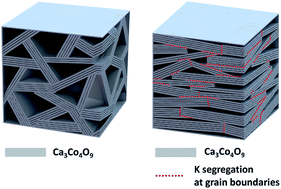Role of oversized dopant potassium on the nanostructure and thermoelectric performance of calcium cobaltite ceramics
Abstract
The impact of the non-stoichiometric addition of potassium (K) on the nanostructure and thermoelectric performance of misfit layered calcium cobaltite (Ca3Co4O9) ceramics is reported. The samples were prepared with the designed nominal composition of Ca3Co4O9Kx (x = 0, 0.05, 0.1, 0.15, and 0.2). The K addition promoted the crystal growth and improved the crystal texture. The nanostructure and chemical analysis revealed the segregation of K at the Ca3Co4O9 grain boundaries, while the Ca3Co4O9 grain interior was free of K. At the optimal doping level, the dopant K grain boundary segregation reduced the electrical resistivity and simultaneously increased the Seebeck coefficient, resulting in a large increase in the power factor. At 320 K, the sample Ca3Co4O9K0.1 achieved the power factor of 930 μW K−2 m−1, which is 2.25 times higher than 412 μW K−2 m−1 from pristine Ca3Co4O9 and by far, the highest power factor at room temperature regime for the Ca3Co4O9 ceramics. The impact of the dopant segregation on the ionic diffusion along the grain boundaries and its resultant thermoelectric performance enhancement of Ca3Co4O9 ceramics are discussed.



 Please wait while we load your content...
Please wait while we load your content...